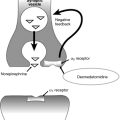Anesthesia for patients with carcinoid tumors
Michelle A.O. Kinney, MD, John A. Dilger, MD and Toby N. Weingarten, MD
Anesthetic management of patients with carcinoid tumors
Preoperative anesthetic management
Intraoperative anesthetic management
The presence of hypovolemia or electrolyte abnormalities and the possibility of right-sided cardiac valvular lesions should be taken into account when planning for induction and maintenance of anesthesia. Gentle surgical skin preparation to avoid tumor compression is advised (Box 175-1). The use of histamine-releasing drugs should probably be avoided in patients with carcinoid tumors, although these drugs have been used frequently in the past without complications. Phenylephrine and amrinone have been safely used in patients with carcinoid syndrome. However, even very low doses of β-adrenergic agonists (e.g., 5 μg of intravenously administered epinephrine) have been shown to stimulate the release of vasoactive substances, but the action of these drugs can be blunted if the patient has received an adequate dose of octreotide. In a hypotensive patient, if the cause of hypotension is secondary to carcinoid crisis, additional octreotide and fluid should be administered. β-Adrenergic agonists should be used only when the cause of hypotension is thought to be secondary to decreased systemic vascular resistance or decreased cardiac output from factors unrelated to tumor activity.






